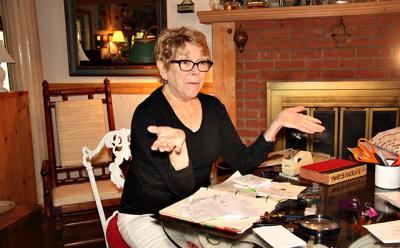Plenty Of Ticks, No Chiggers

“It’s tick city in here,” said Patricia Hope, during a recent visit to her house in the Northwest Woods area of East Hampton. Over the past year, Ms. Hope has spent hours each day collecting, identifying, and preserving ticks.
Ms. Hope, 73, is a former biology teacher who pays meticulous attention to detail, which makes describing her study of arthropods tricky — with “obsession” too pejorative and “hobby” ultimately too lightweight. She prefers “keen interest,” which still comes short of describing her collection of a halfdozen binders, each with laminated page after laminated page of local nuisances.
Four summers ago, after walking around Northwest Creek, Ms. Hope returned home with itchy, swollen bites circling her ankles and wrists. The bites, and subsequent rash, differed from previous tick bites. Peter Van Scoyoc, a friend and fellow naturalist, thought the bites resembled those of chiggers, a type of mite.
Debate has raged here for quite some time about whether the East End is indeed home to chiggers, in addition to dog, deer, and lone star ticks. Partly complicating matters, each arthropod varies in size and shape, depending on its gender and life stages — larva, nymph, and adult.
“My aim was to clarify my own position in the debate by observing, collecting, identifying, and preserving these organisms within a specific parameter,” Ms. Hope explained.
“I don’t have to seek them out. They come to me,” she said, while holding court in her living room, which doubles as a makeshift laboratory. “All I needed was a light-colored dog, a microscope, and a strong stomach.”
In April last year, Ms. Hope decided to start keeping a formal tally, limiting her area of study to those six and eight-legged critters she collects, including those found either on her person or on her dog.
Three times a day she takes walks with Carly, a 5-year-old yellow Lab, near the preserve that surrounds her East Hampton property. The dog, on a 50-foot-long tether, is a magnet for ticks, which abound in the wooded habitat. Once home, Ms. Hope combs the dog’s coat for visible ticks and affixes them with Scotch tape to a dated index card.
The almost-invisible larvae become visible after feasting on a blood meal. The engorged larvae resemble tiny black sesame seeds, quickly dropping off into Carly’s bed, having completed the first stage of their life cycle. Ms. Hope collects them while changing the bedding each day.
During last week’s visit, Ms. Hope affixed three lone star engorged larvae and crushed one with a pencil eraser to show Carly’s blood oozing out.
“Every tick you collect is one that won’t go to the dance next year,” said Ms. Hope, who sees a slight reduction in the local tick population as an added benefit of her research.
Last year, Ms. Hope collected around 2,500 ticks. This year’s tally includes 2,475 lone star ticks, 10 deer ticks — and zero chiggers.
“I can’t conclude a negative. I can’t tell you there are no chiggers in East Hampton,” Ms. Hope said, peering out from her white microscope. “But over three years, I’ve viewed over 7,000 ticks, and I have not seen one chigger.”
Based on her findings, Ms. Hope has concluded that East Hampton’s tick season runs from April to November, with the adult lone star peaking around Memorial Day weekend, when Ms. Hope amassed 109 ticks during one 24-hour period. Another peak occurred in late August, when the lone star larvae hatch, resulting in those annoying, itchy, red bites, which resemble those of chiggers. Ms. Hope collected over 1,500.
So far, compared to last year, she has collected more lone star ticks and fewer deer ticks. Next year, she hopes to add weather to her list of daily metrics, logging high and low temperatures and precipitation.
When not cataloging ticks, Ms. Hope, who has not come down with any of the known tick-borne diseases, stays busy watching baseball and spending time with her 4-month-old grandson. In 2007, she retired from East Hampton High School, where she had worked for 33 years as a biology teacher and chaired its science department for eight years. In July of 2014 she surprised her colleagues by resigning from the East Hampton School Board after serving as its president.
In recent months, she also began co-chairing a 10-member education committee that is examining how local school districts might operate more efficiently, with an eye toward shared resources and cost-savings.
This winter, Ms. Hope plans to organize three years’ worth of tick data, superimposing weather systems on the information she has gathered and synthesizing her research. She is curious, for instance, about whether this spring’s prolonged snowpack led to an unusually robust lone star tick population and the extent to which the rise of various tick populations is tied to the changing seasons.
“At this point, I’m able to say that the hypothesis I was testing, which was that we have chiggers in East Hampton, is not supported by the evidence,” concluded Ms. Hope, whose passion for “good, thorough, simple” science remains undiminished. “If I have a purpose, it’s to use accepted methods to satisfy curiosity, educate myself and others, and contribute to my community.”
